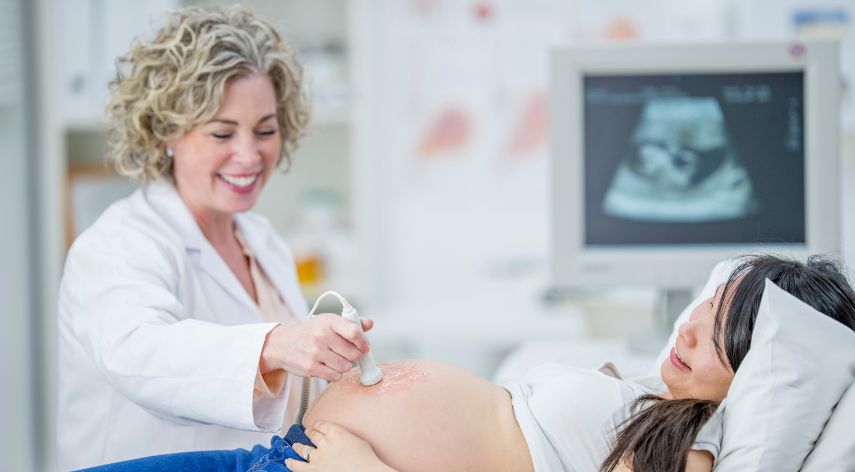Did you conceive recently? If yes, then the date of your first pregnancy ultrasound is what you are eagerly looking forward. There is a great chance to get hold of a glimpse of your little one. Though ultrasound seems to be really exciting, they are an important diagnostic medical procedure that will keep you and your would-be-born baby safe during the pregnancy period. There are times when ultrasound seems to be stressful for parents, when they diagnose some issue in pregnancy or baby.
Purpose of Ultrasound in Pregnancy
With ultrasound, you can see the images of your baby’s body and organs as well as check their health and development. Also, ultrasound may be used for:
- Know your pregnancy
- Find out the number of weeks you are pregnant
- Determine the number of foetuses you are carrying of fetuses you are carrying
- Detect unusualities in the uterus and cervix
- Observe your pregnancy
- Find out any fetal abnormalities
- Look at diagnostic procedures such as amniocentesis and chorionic villus sampling
- Noting amniotic volume
- Check your placenta health
- Discover pregnancy complications you may experience like unusual bleeding
- Determine the position of your baby when birth draws closer
Risks with ultrasound
Ultrasound technology has been used for several years in pregnancy and there is no risk involved when used in an appropriate way. The major concern with ultrasound is that they cannot identify all the fetal abnormalities and they produce false positive results, at times.
Different kinds of Ultrasounds used during pregnancy
When you perform pregnancy ultrasound, you may think about the one which occur mid-way during your pregnancy phase. This is the time period when you can find out things like gender of your baby. The mid-pregnancy ultrasound is what all pregnant women have which involves detailed examination and view of your baby.
There are other types of ultrasounds which you may have to perform at the time of pregnancy and all of them have different purposes.
There are two types of ultrasound used during pregnancy and these are – transvaginal and transabdominal.
Transvaginal Ultrasound
There is a wand-shaped transducer placed inside the vagina in this type of ultrasound. Transvaginal ultrasounds can be used in early pregnancy to confirm your pregnancy, check heart rate and position of the baby, detect signs of ectopic pregnancy, and know the number of fetuses present. But they can be used later on during pregnancy when abdominal ultrasounds fail to give enough information.
Transabdominal Ultrasound
Transabdominal ultrasounds use a transducer placed on the abdomen to see your baby and check on your pregnancy. This routine receives thorough transabdominal ultrasound for around 18 to 22 weeks during your pregnancy though they may be used later on for pregnancy when there is any concern to be monitored.
3D Ultrasound
This kind of ultrasound is performed either don transvaginally or transabdominally. 3D ultrasound can be used when you want to see your baby’s detailed images. It detects certain conditions such as facial abnormalities and neural tube defects.
Doppler Ultrasound
Doppler ultrasounds can be used to view movement in the blood vessels and provide information about blood flow of your baby and blood flow in your placenta and uterus.
Fetal Echocardiography
Fetal Echocardiography will enable gynaecologists to view detailed image of your baby’s heart and heart structures. It can be used when there is a suspect of congenital heart defect.
How you can prepare for ultrasound
There are cases when you need to come for an ultrasound with a full bladder. The full bladder give the technician clear view of the structures they want to image.
If you want to perform a transabdominal ultrasound, then you will have to wear loose fitting clothing. The technician will have easy access to your belly and you may be given detailed instruction on how to prepare for the examination.
What you can expect during an ultrasound
A transvaginal examination will be quite similar to pelvic examination you have had performed. You will be asked to empty bladder and lie on your back at the table in a gown.
The transducer wand consists of sterile protective sheath which gets lubricated for comfort and easy insertion. The wand will then be inserted inside your vagina and moved gently so the gynae expert can find important structures to view. You can see the images of your fetus and uterus on the video screen.
What happens during a transabdominal examination
You need to lie down on the table for performing transabdominal ultrasound and your belly will be exposed. The sonographer uses special gel to smear across the belly and run transducer across your belly by pausing at different points when images are generated.
Depending on the exact purpose of the examination, the sonographer may spend time to find the structures they want. During this 18 to 22 week examination, the sonographer views the list of items so this exam may take some time.
Your ultrasound examination may be a highlight of your pregnancy and most ultrasounds are really exciting. It is important to know that these medical procedures ensure your healthy pregnancy and safe delivery. So, ultrasounds are used for medical purposes only, when prescribed by a gynaecologist. The results of pregnancy ultrasound may be a matter of concern for the expectant parents, in some cases. The Gynae Clinic at the ultrasound centre in Harley Street will do everything to keep you safe and ensure the best result for your pregnancy.

